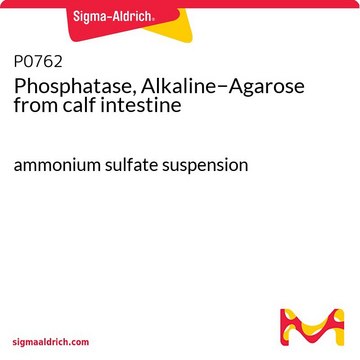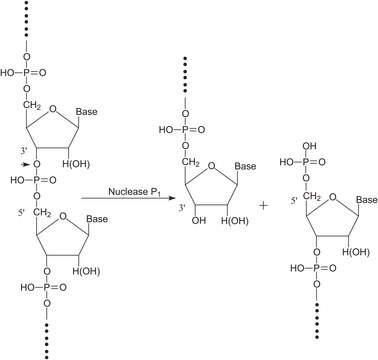Alle Fotos(1)
Wichtige Dokumente
P4069
Phosphatase, alkalisch aus E. coli
buffered aqueous glycerol solution, 20-50 units/mg protein (in glycine buffer)
Synonym(e):
Orthophosphor-Monoesterphosphohydrolase (alkalisches Optimum)
Anmeldenzur Ansicht organisationsspezifischer und vertraglich vereinbarter Preise
Alle Fotos(1)
About This Item
Empfohlene Produkte
Biologische Quelle
Escherichia coli
Qualitätsniveau
Form
buffered aqueous glycerol solution
Spezifische Aktivität
20-50 units/mg protein (in glycine buffer)
Fremdaktivität
DNase, RNase, none detected
Lagertemp.
−20°C
Suchen Sie nach ähnlichen Produkten? Aufrufen Leitfaden zum Produktvergleich
Anwendung
Alkaline phosphatase is used for conjugation to antibodies and other proteins for ELISA, Western blotting, and histochemical detection. It may be used for protein labeling when high sensitivity is required. Product P4069 is provided as a buffered aqueous glycerol solution.
Phosphatase, Alkaline from Escherichia coli has been used:
- in fluorometric assay to determine its enzyme activity
- in the dephosphorylating enzyme cocktail for dephosphorylation of peptides
- in treating the nerve and HL60 cell lysate for β-hydroxy β-methylglutaryl-Coenzyme A (HMG-CoA) reductase activity
Biochem./physiol. Wirkung
Alkaline phosphatase is a model enzyme for understanding phosphomonoesterase. It is used in various biochemical methods and enzyme linked immunosorbent assay (ELISA).
Alkaline phosphatase, from Escherichia coli, is a dimeric, non-glycosylated protein which mainly reside in the periplasmic space. Three known isoforms exist. The enzyme requires zinc, and is activated by magnesium. E. coli akaline phosphatase has a broad specificity for phosphate esters.
Vorsicht
Alkaline phosphatase in 5 mM EDTA, pH 8, will be irreversibly heat inactivated at 75°C for 10 minutes.
Einheitendefinition
Eine Einheit hydrolysiert 1,0 μmol p-Nitrophenylphosphat je Min. bei einem pH-Wert von 10,4 und 37 °C.
Physikalische Form
Solution in 5 mM Tris-HCl, pH 7.4, 0.5 mM MgCl2, 0.5 mM ZnCl2, 50% (w/v) glycerol
Hinweis zur Analyse
Protein determined by biuret.
Inhibitor
Produkt-Nr.
Beschreibung
Preisangaben
Substrat
Ähnliches Produkt
Produkt-Nr.
Beschreibung
Preisangaben
Signalwort
Danger
H-Sätze
P-Sätze
Gefahreneinstufungen
Resp. Sens. 1
Lagerklassenschlüssel
10 - Combustible liquids
WGK
WGK 1
Flammpunkt (°F)
Not applicable
Flammpunkt (°C)
Not applicable
Persönliche Schutzausrüstung
Eyeshields, Gloves, type N95 (US)
Hier finden Sie alle aktuellen Versionen:
Besitzen Sie dieses Produkt bereits?
In der Dokumentenbibliothek finden Sie die Dokumentation zu den Produkten, die Sie kürzlich erworben haben.
Kunden haben sich ebenfalls angesehen
Phospho-iTRAQ data article: Assessing isobaric labels for the large-scale study of phosphopeptide stoichiometry
Glibert P, et al.
Data in Brief, 4(2), 60-65 (2015)
Sensitive fluorogenic substrate for alkaline phosphatase
Levine MN and Raines RT
Analytical Biochemistry, 418(2), 247-252 (2011)
The prion protein and cellular cholesterol homeostasis
Diomede L, et al.
Neurobiology of Lipids, 1(2), 8-14 (2002)
Lionel M Igaz et al.
The American journal of pathology, 173(1), 182-194 (2008-06-07)
TAR DNA-binding protein (TDP-43) has been recently described as a major pathological protein in both frontotemporal dementia with ubiquitin-positive inclusions (FTLD-U) and amyotrophic lateral sclerosis. However, little is known about the relative abundance and distribution of different pathological TDP-43 species
Jong Kil Lee et al.
The Journal of experimental medicine, 211(8), 1551-1570 (2014-07-23)
In Alzheimer's disease (AD), abnormal sphingolipid metabolism has been reported, although the pathogenic consequences of these changes have not been fully characterized. We show that acid sphingomyelinase (ASM) is increased in fibroblasts, brain, and/or plasma from patients with AD and
Unser Team von Wissenschaftlern verfügt über Erfahrung in allen Forschungsbereichen einschließlich Life Science, Materialwissenschaften, chemischer Synthese, Chromatographie, Analytik und vielen mehr..
Setzen Sie sich mit dem technischen Dienst in Verbindung.







